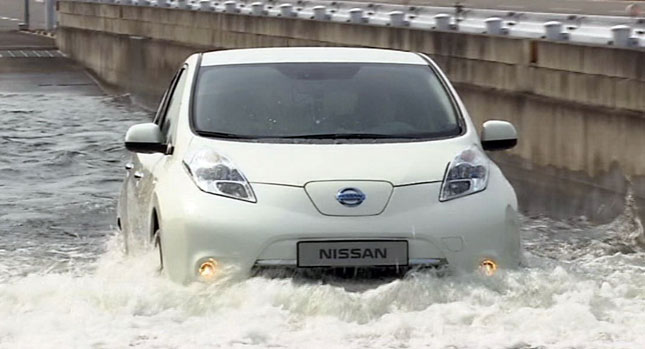The much-talked about Chevy Volt safety probe on the issue of its lithium-ion batteries and the recent announcement that 50 of the Fisker Karmas already delivered may face a similar short circuit problem, has led to much skepticism and debate about whether electric cars are safe enough in the event of an accident.
There are always two sides to the coin though and Nissan is currently making hay out of its rival’s problems.
After the March tsunami that devastated Japan and its manufacturers, about two dozen Leaf EVs were destroyed. According to Nissan, none of the cars caught fire and their battery packs remained intact thanks to the airtight exosleketon, plus an additional two layers of protection that surround them.
“Considering how they were tossed around and crushed, we think that is a very good indication of the safety performance of that vehicle”, said director of product safety for Nissan North America, Bob Yakushi. Although this time Nissan didn’t mention any names, the jab at the Volt was as clear as a bell.
 The Leaf battery pack is encased in an all-steel cover, a solution which Ford also chose for the recently launched Focus Electric, while GM encloses the Volt batteries in a T-shaped tray made of steel, but with a plastic cover.
The Leaf battery pack is encased in an all-steel cover, a solution which Ford also chose for the recently launched Focus Electric, while GM encloses the Volt batteries in a T-shaped tray made of steel, but with a plastic cover.
GM representative Robert D. Peterson replied that the Volt’s battery “is fully encased by the steel floor pan or rails” and that the material chosen for the plastic cover does not conduct electricity.
The company has already stated that it is cooperating with the NHTSA to locate the source of the problem, which as is the case with the Fisker Karma, may be a coolant leak that causes a short circuit.
GM is also examining whether it should redesign the Volt battery pack. The Detroit company’s senior vice president for global product development, Mary Barra, confirmed that “if we have to do something we will”, but was adamant that the Volt was not launched before it was ready but “was fully developed”.
Story References: Detnews
VIDEO







